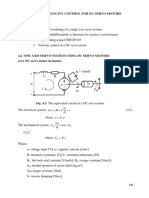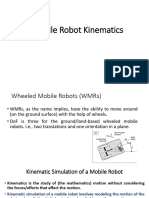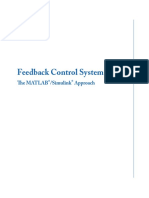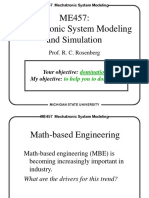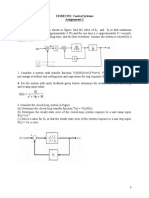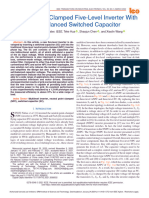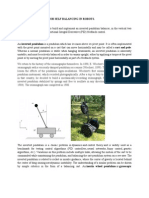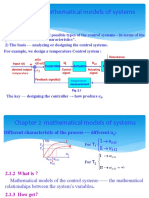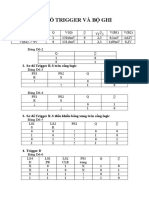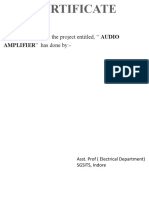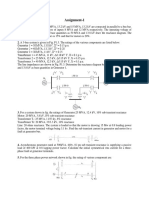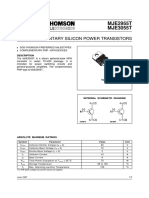0 ratings0% found this document useful (0 votes)
761 views19 pagesControl Systems Engineering, Sixth Edition
control
Uploaded by
sethCopyright
© © All Rights Reserved
We take content rights seriously. If you suspect this is your content, claim it here.
Available Formats
Download as PDF or read online on Scribd
0 ratings0% found this document useful (0 votes)
761 views19 pagesControl Systems Engineering, Sixth Edition
control
Uploaded by
sethCopyright
© © All Rights Reserved
We take content rights seriously. If you suspect this is your content, claim it here.
Available Formats
Download as PDF or read online on Scribd
You are on page 1/ 19
C chapter Learning outcomes 9
After completing this chapter the student will be able to:
‘© Make and interpret a basic Routh table to determine the stability of a system
(Gections 6.1-6.2)
‘© Make and interpret a Routh table where either the first element ofa row is zero or an
entite row is zero (Sections 6.3-6.4)
© Use a Routh table to determine the stability ofa system represented in state space
(Section 6.5)
(case study Learning outcomes 9
You will be able to demonstrate your knowledge of the chapter objectives with case
studies as follows:
‘© Given the antenna azimuth position control system shown on the front endpapers,
you will be able to find the range of preamplifier gain to keep the system stable.
© Given the block diagrams for the UFSS vehicle's pitch and heading control systems on,
the back endpapers, you will be able to determine the range of gain for stability of
the pitch or heading contiol system.
sae Space
301
302
Chapter Stability
(6.1. Introduction
In Chapter 1, we saw that three requirements enter into the design of a contro!
system: transient response, stability, and steady-state errors. Thus far we have
covered transient response, which we will revisit in Chapter 8. We are now ready
to discuss the next requirement, stability.
Stability is the most important system specification. If a system is unstable,
transient response and steady-state errors are moot points. An unstable system
cannot be designed for a specific transient response or steady-state error require-
ment. What, then, is stability? There are many definitions for stability, depending
upon the kind of system or the point of view. In this section, we limit ourselves to
linear, time-invariant systems.
In Section 1.5, we discussed that we can control the output of a system if the
steady-state response consists of only the forced response. But the total response of a
system is the sum of the forced and natural responses, or
(0) = creat) + Coat) (6.1)
‘Using these concepts, we present the following definitions of stability, instability, and
marginal stability:
A linear, time-invariant system is stable if the natural response approaches 2er0 as
time approaches infinity.
A linear, time-invariant system is wnstable ifthe natural response grows without
‘bound as time approaches infinity.
A linear, time-invariant system is marginally stable ifthe natural response neither
decays nor grows but remains constant or oscillates as time approaches infinity.
‘Thus, the definition of stability implies that only the forced response remains as the
natural response approaches zero.
‘These definitions rely on a description of the natural response. When one is
ooking atthe total response, itmay be difficult o separate the natural response from
the forced response. However, we realize that if the input is bounded and the total
response is not approaching infinity as time approaches infinity, then the natural
response is obviously not approaching infinity. Ifthe input is unbounded, we see an
‘unbounded total response, and we cannot arrive at any conclusion about the stability
of the system; we cannot tell whether the total response is unbounded because the
forced response is unbounded or because the natural response is unbounded, Thus,
our alternate definition of stability, one that regards the total response and implies
the first definition based upon the natural response, is thi
‘A system is stable if every bounded input yields a bounded output.
We call this statement the bounded-input, bounded-output (BIBO) definition of
stability.
Let us now produce an alternate definition for instability based on the total
response rather than the natural response. We realize that if the input is bounded but
the total response is unbounded, the system is unstable, since we can conclude that
the natural response approaches infinity as time approaches infinity. Ifthe input is
unbounded, we will see an unbounded total response, and we cannot draw any
conclusion about the stability of the system; we cannot tell whether the total
response is unbounded because the forced response is unbounded or because the
6.1 Introduction
natural response is unbounded. Thus, our alternate definition of instability, one that
regards the total response, is this:
A system is unstable if any bounded input yields an unbounded output.
‘These definitions help clarity our previous definition of marginal stability,
which really means that the system is stable for some bounded inputs and unstable
for others. For example, we will show that if the natural response is undamped, a
bounded sinusoidal input of the same frequency yields a natural response of growing
oscillations. Hence, the system appears stable for all bounded inputs except this one
sinusoid. Thus, marginally stable systems by the natural response definitions are
included as unstable systems under the BIBO definitions.
Let us summarize our definitions of stability for linear, time-invariant systems.
Using the natural response:
1. A system is stable if the natural response approaches zero as time approaches,
infinity.
2. A system is unstable if the natural response approaches infinity as time
approaches infinity.
3. Asystem is marginally stable ifthe natural response neither decays nor grows but
remains constant or oscillates.
Using the total response (BIBO):
1. A system is stable if every bounded input yields @ bounded output
2. A system is unstable if any bounded input yields an unbounded output.
Physically, an unstable system whose natural response grows without bound
‘can cause damage to the system, to adjacent property, or to human life. Many times
systems are designed with limited stops to prevent total runaway. From the
perspective of the time response plot of a physical system, instability is displayed
by transients that grow without bound and, consequently, a total response that does
not approach a steady-state value or other forced response."
How do we determine ifa system is stable? Let us focus on the natural response
definitions of stability. Recall from our study of system poles that poles in the left
half-plane (Ihp) yield either pure exponential decay or damped sinusoidal natural
responses. These natural responses decay to zero as time approaches infinity. Thus, if
the closed-loop system poles are in the left half of the plane and hence have a
negative real part, the system is stable. That is, stable systems have closed-loop
transfer functions with poles only in the left half plane.
Poles in the right half-plane (chp) yield either pure exponentially increasing or
exponentially increasing sinusoidal natural responses. These natural responses
approach infinity as time approaches infinity. Thus, if the closed-loop system poles
are in the right half of the s-plane and hence have a positive real part, the system is
unstable, Also, poles of multiplicity greater than 1 on the imaginary axis lead to
the sum of responses of the form Af" cos (at + 9), where m= 1,2,..., which also
approaches infinity as time approaches infinity. Thus, unstable systems have closed-
loop transfer functions with at least one pole in the right half plane and/or poles of
‘multiplicity greater than I on the imaginary axis.
"Care must be taken here to distinguish between natura responses growing without hound and forced
‘response. such as a ramp or exponential inerease, that also grows without bound. A system whose forced
response approsehes infinity is stable as long s the natural response approaches zea.
303
304
FIGURE6.1 Closed-Loop
poles and response:
a.stable system;
beunstable system
Chapter 6 Stability
Finally, a system that has imaginary axis poles of multiplicity 1 yields pure
sinusoidal oscillations as a natural response. These responses neither increase nor
decrease in amplitude. Thus, marginally stable systems have closed-loop transfer
Junctions with only imaginary axis poles of multiplicity I and poles inthe left half plane.
As an example, the unit step response of the stable system of Figure 6.1(a) is
‘compared to that of the unstable system of Figure 6.1(b). The responses, also shown
in Figure 6.1, show that while the oscillations for the stable system diminish, those for
the unstable system increase without bound. Also notice that the stable system's
response in this case approaches a steady-state value of unity.
Iis not always a simple matter to determine if a feedback control system is
stable. Unfortunately, a typical problem that arises is shown in Figure 6.2. Although
wwe know the poles of the forward transfer function in Figure 6.2(a), we do not know
the location of the poles of the equivalent closed-loop system of Figure 6.2(b)
without factoring or otherwise solving for the roots.
However, under certain conditions, we can draw some conclusions about
the stability of the system. First, if the closed-loop transfer function has only
3 ©),
$ SGD
Sable sytem
‘Stable ha =
lesyments ities
closed-loop poles: Tiee Greet
(oot seal)
@
R=} ¥ Al) 7 4),
ae
esate ten
si AAN
* AA
“jis lo Vis 0
‘Unstable system's \
osed-oop poles Time (seconds)
(ooeto scale)
o
62 Routh-Hurwitz Criterion
RO ge) 8 06+) oo)
+ Fee Oe HEFT,
@
id aa ci). FIGURE6.2 Common cause
+26 + 24s + 123237 + 19305 420 Stipenbieme in Being cones
Joop poles: a. original system;
o ‘equivalent system
left-half-plane poles, then the factors of the denominator of the closed-loop system
transfer function consist of products of terms such as (s+ a,), where a is real and
positive, or complex with a positive real part. The product of such terms is a
polynomial with all positive coefficients No term of the polynomial can be missing,
since that would imply cancellation between positive and negative coefficients or
imaginary axis roots in the factors, which is not the case. Thus, a sufficient condition
for a system to be unstable is that all signs of the coefficients of the denominator of
the closed-loop transfer function are not the same. If powers of s are missing, the
system is either unstable or, at best, marginally stable. Unfortunately, if all coef-
ficients of the denominator are positive and not missing, we do not have definitive
information about the system's pole locations.
If the method described in the previous paragraph is not sufficient, then a
computer can be used to determine the stability by calculating the root locations of
the denominator of the closed-loop transfer function. Today some hand-held
calculators can evaluate the roots of a polynomial. There is, however, another
method to test for stability without having to solve for the roots of the denominator.
We discuss this method in the next section.
6.2. Routh-Hurwitz Criterion
In this section, we learn a method that yields stability information without the need
to solve for the closed-loop system poles. Using this method, we can tell how many
closed-loop system poles are in the left half-plane, inthe right half-plane, and on the
Jeo-axis. (Notice that we say how many, not where.) We can find the number of poles
in each section of the s-plane, but we cannot find their coordinates. The method is
called the Rowth-Hurwitz criterion for stability (Routh, 1905).
‘The method requires two steps: (1) Generate a data table called a Row table
and (2) interpret the Routh table to tell how many closed-loop system poles are in
the left half-plane, the right half-plane, and on the jo-axis. You might wonder why we
study the Routh-Hiurwitz criterion when modern calculators and computers can tell
us the exact location of system poles. The power of the method lies in design rather
than analysis. For example, ifyou have an unknown parameter in the denominator of
a transfer function, itis dificult to determine via a calculator the range of this
parameter to yield stability. You would probably rely on trial and error to answer the
The coefficients ean also be made all negative by multiplying the polynomial by —1. Tis operation does
not change the root lation,
306 Chapter6 Stability
stability question. We shall see later that the Routh-Hurwitz eriterion can yield a
closed-form expression for the range of the unknown parameter.
In this section, we make and interpret a basic Routh table. In the next section,
‘we consider two special cases that can arise when generating this data table.
Generating a Basic Routh Table
ERSTE Look at the equivalent closed-loop transfer function shown in Fig-
aah tay +a +04 m9 ure 63. Since we are interested in the system poles, we focus our
FIGURE63 Equivalent closedoop wansfer _ attention on the denominator. We first create the Routh table shown
function in Table 6.1. Begin by labeling the rows with powers of s from the
highest power of the denominator of the closed-loop transfer func-
tion tos°, Next start with the coefficient ofthe highest power of in the denominator
and list, horizontally in the first row, every other coefficient, In the second row, list
horizontally, starting with the next highest power of s, every coefficient that was
skipped in the first row.
‘The remaining entries are filled in as follows. Each entry is a negative determi-
nant of entries in he previous tworows divided by the entry in the firstcoluran directly
above the calculated row. The left-hand column of the determinant is always the first
column of the previous two rows, and the right-hand column is the elements of the
ccolumnabove andto theright. The table iscomplete when alloftherowsare completed
down to", Table 6.2 the completed Routh table. Let us look at an example.
A) Ma) a
TAGLE 6.1. Initial layout for Routh table TABLE 6.2 Completed Routh table
“ a o % #
a a 0 s
Example 6.1
Creating a Routh Table
PROBLEM: Make the Routh table for the system shown in Figure 6.4(a)
SOLUTION: The first step isto find the equivalent closed-loop system because We
‘want to test the denominator of this function, not the given forward transfer
RO $ > Eis), 1000. Ch
FIGURE6.4 a. Feedback Ga Bie + HFS) A) 1000 ce)
system for Example 6.1; PeIe +3155 1080
equivalent closed-
loop system o 0
62 Routh-Hurwitz Criterion 307
TABLE 6.3 Completed Routh table for Example 6.1
function, for pole location. Using the feedback formula, we obtain the equivalent
system of Figure 64(6). The Routh-Hurwitz criterion will be applied to this
denominator. First label the rows with powers of s from s* down to s* in a vertical
column, as shown in Table 6.3. Next form the first row of the table, using the
coefficients of the denominator of the closed-loop transfer function. Start with
the coefficient of the highest power and skip every other power of Now form the
second row with the coefficients of the denominator skipped in the previous step.
Subsequent rows are formed with determinants, as shown in Table 6.2.
For convenience, any row of the Routh table can be multiplied by a positive
constant without changing the values of the rows below. This can be proved by
examining the expressions for the entries and verifying that any multiplicative
‘constant from a previous row cancels out. In the second row of Table 6.3, for
example, the row was multiplied by 1/10. We see later that care must be taken not to
rultiply the row by a negative constant.
Interpreting the Basic Routh Table
Now that we know how to generate the Routh table, let us see how to interpret it.
The basic Routh table applies to systems with poles in the left and right half-planes
Systems with imaginary poles and the kind of Routh table that results will be
discussed in the next section. Simply stated, the Routh-Hurwitz criterion declares
that the number of roots of the polynomial that are inthe right half-plane is equal to
the number of sign changes in the first column.
If the closed-loop transfer function has all poles in the left half of the s-plane,
the system is stable. Thus, a system is stable if there are no sign changes in the first
column of the Routh table, For example, Table 63 has two sign changes in the
first column. The first sign change occurs from 1 in the s? row to ~72in the s! row.
“The second occurs from ~72 in the s* row to 103 in the s° row. Thus, the system of
Figure 6.4 is unstable since two poles exist in the right half-plane.
Skill-Assessment Exercise 6.1
PROBLEM: Make a Routh table and tell how many roots of the following els
polynomial are in the right half-plane and in the left half-plane. ap
POs) = 387 $998 +68 4 Ast 4 T+ BF +2846 ‘ental soins
ANSWER: Four in the right half-plane (rhp), three in the left half-plane (Ihp).
‘The complete solution is at www.wiley.com/collegeinise.
308 Chapter 6 Stability
‘Now that we have described how to generate and interpret a basic Routh table,
let us look at two special cases that can arise.
¢ 6.3 Routh-Hurwitz Criterion: Special Cases
‘Two special cases can occur: (1) The Routh table sometimes will have a zero only in
the first column of a row, or (2) the Routh table sometimes will have an entire row
that consists of zeros. Let us examine the first case.
Zero Only in the First Column
If the first element of a row is zer0, division by zero would be required to form the
next row. To avoid this phenomenon, an epsilon, c, is assigned to replace the zero in
the first column. The value ¢ is then allowed to approach zero from either the
positive or the negative side after which the signs of the entries in the first column
can be determined, Let us look at an example.
Example 6.2
Stability via Epsilon Method
Trylt 6.1 PROBLEM: Determine the stability of the closed-loop transfer function
Use the following MATLAB 46
statement 0 ind the poles of
the closed-loop transfer 13) = Sy apa +P ESS (62)
function in Eq, (62)
See 2a ay SOLUTION: The solution is shown in Table 6.4. We form the Routh table by using
the denominator of Eq. (6.2). Begin by assembling the Routh table down to the row
where a zero appears only inthe first column (the s* row). Next replace the zero by
asmall number, «,and complete the table. ‘To begin the interpretation, we must first
assume a sign, positive or negative, for the quantity «. Table 65 shows the first
column of Table 6.4 along with the resulting signs for choices of positive and
e negative.
TABLE 6.5 Determining signs in first column of a Routh table with
zero as frst element in a row
TABLE 6.4 Completed Routh table for
Brame inva oo on
; ; an oe 1 : -
: } oe: 2 :
eo wat Po, 4 ae 2
| Sete i og : : i
Ae ~ 49 ~ 662 ~ s
s 0 7 Te 14
o 0 ° 3 + +
63. Routh-Hurwite Criterion: Special Cases
Ife is chosen positive, Table 6.5 will show a sign change from the s* row to the
4? row, and there will be another sign change from the s? row to the s' row. Hence,
the system is unstable and has two poles in the right half-plane.
‘Alternatively, we could choose ¢ negative. Table 6.5 would then show a
sign change from the s* row to the s° row. Another sign change would occur
from the s° row to the s? row. Our result would be exactly the same as that for
a positive choice for ¢, Thus, the system is unstable, with two poles in the right
half-plane.
Students who are performing the MATLAB exercises and want to
explore the added capability of MATLAB's Symbolic Math Toolbox
should now run chésp1 in Appendix F at waw.wiley.com/college/
nise. You will learn how to use the Symbolic Math Toolbox to
calculate the values of cells in a Routh table even if the table
contains symbolic objects, such as ¢. You will see that the
Symbolic Math Toolbox and MATLAB yield an alternate way to gen-
erate the Routh table for Example 6.2.
309
Sebi Math
‘Another method that can be used when a zero appears only in the first column
of a row is derived from the fact that a polynomial that has the reciprocal roots of the
original polynomial has its roots distributed the same—right half-plane, left half-
plane, or imaginary axis—because taking the reciprocal of the root value does not
‘move it to another region. Thus, if we can find the polynomial that has the reciprocal
roots of the original, it is possible that the Routh table for the new polynomial will
not have @ zero in the first column. This method is usually computationally easier
than the epsilon method just described.
We now show that the polynomial we are looking for, the one with the
reciprocal roots, is simply the original polynomial with its coefficients written in
reverse order (Phillips, 991). Assume the equation
SP dy alt bet ays + a9 = 0 (63)
If sis replaced by 1/d, then d will have roots which are the reciprocal of. Making this
substitution in Eq, (6.3),
(yma etal
Factoring out (1/d)",
[ee @ eee G) 9G) ]
= (Je Fayed bess bayeY + aga] = 0
) +a =0 (64)
65)
‘Thus, the polynomial with reciprocal roots is a polynomial with the coefficients
written in reverse order. Let us redo the previous example to show the computa-
tional advantage of this method,
310 Chapter6 Stability
Example 6.3
Stability via Reverse Coefficients
PROBLEM: Determine the stability of the closed-loop transfer function
10
ST oT TTS
(6.6)
SOLUTION: First write a polynomial that has the reciprocal roots of the denomi-
nator of Eq. (6.6). From our discussion, this polynomial is formed by writing the
denominator of Eq. (6.6) in reverse order. Hence,
D(s) = 35 + Ss +65 +3 +2541 (67)
‘We form the Routh table as shown in Table 66 using Eq. (6.7). Since there are two
sign changes, the system is unstable and has two right-half-plane poles. This is the
same as the result obtained in Example 6.2. Notice that Table 6.6 does not have a
zero in the first column,
TABLE 6.6 Routh table for Example 63
# 3 6 a
* 5 3 1
# 42 14
133 1
Entire Row is Zero
‘We now look at the second special case. Sometimes while making a Routh table, we
find that an entire row consists of zeros because there is an even polynomial that is a
factor of the original polynomial. This case must be handled differently from the case
of a zero in only the first column of a row. Let us look at an example that
demonstrates how to construct and interpret the Routh table when an entire row
of zeros is present.
Example 6.4
Stability via Routh Table with Row of Zeros
PROBLEM: Determine the number of right-half-plane poles in the closed-loop
transfer function
10
SETAE + TT (68)
Ts) =
SOLUTION: Start by forming the Routh table for the denominator of Eq. (68)
(Gee Table 67). At the second row we multiply through by 17 for convenience. We
stop at the third row, since the entire row consists of zeros, and use the following |
63 Routh-Hurwitz Criterion: Special Cases
TABLE 6.7 Routh table for Example 64
1 6 8
Ft. a 6 68
S @ 41 8 # 3 # #0
© 3 8 0
1
s! ; 0 0
” 8 0 0
procedure, First we return to the row immediately above the row of zeros and
form an auxiliary polynomial, using the entries in that row as coefficients. The
polynomial will start with the power of s in the label column and continue by
skipping every other power of s. Thus, the polynomial formed for this example is,
Pls)=s* +6? +8 (6.9)
Next we differentiate the polynomial with respect to s and obtain
9 424 12540 (6.10)
as
Finally, we use the coefficients of Eq, (6.10) to replace the row of zeros. Again, for
convenience, the third row is multiplied by 1/4 after replacing the zeros.
‘The remainder of the table is formed in a straightforward manner by
following the standard form shown in Table 6.2. Table 6.7 shows that all entries
in the first column ate positive. Hence, there are no right-half-plane poles.
an
Let us look further into the case that yields an entire row of
zeros. An entire row of zeros will appear in the Routh table when a
purely even or purely odd polynomial is a factor of the original
polynomial. For example, s* + 5s? +7 is an even polynomial; it has
only even powers of s. Even polynomials only have roots that are
symmetrical about the origin.® This symmetry can occur under three
‘conditions of root position: (1) The roots are symmetrical and real,
(2) the roots are symmetrical and imaginary, or (3) the roots are
uadrantal. Figure 6.5 shows examples of these cases. Each case or
‘combination of these cases will generate an even polynomiel.
It is this even polynomial that causes the row of zeros to
appear. Thus, the row of zeros tells us of the existence of an even
polynomial whose roots are symmetric about the origin. Some of 4: Retlani symmetiea aboot be origin
1 enaginay and symmetrical bout tke erigin ——
these roots could be on the ja~axis. On the other hand,since ja roots fume. stout
h FHGURE6.5 Root positions o generate even
cannot possibly have jw roots. polynomials: A,B, C,or any combination
are symmetric about the origin, if we do not have a row of zeros, we
Another characteristic of the Routh table for the case in
{question is that the row previous to the row of zeros contains the even polynomial
that is a factor of the original polynomial. Finally, everything from the row
containing the even polynomial down to the end of the Routh table is a test of
only the even polynomial. Let us put these facts together in an example.
The polynomial + Se+7e isan example of an odd polynomial: it has enly odd powers of s. O48
polynomials re the product of an even polynomial and an odd power of s Thus, the constant term ofa
‘odd polynomial is alwsys missing,
312
Chapter6 Stability
De SE
Pole Distribution via Routh Table with Row of Zeros
PROBLEM: For the transfer function
ij ee
FP FTES DOS $F SOS FETS IS DO
tell how many poles are in the sight halplane, inthe left half-plane, and on the
joaxis
SOLUTION: Use the denominator of Eq. (6.11) and form the Routh table in
‘Table 68. For convenience the s° row is multiplied by 1/10, and the s° row is,
‘multiplied by 1/20. At the s? row we obtain a row of zeros. Moving back one row to
«f, we extract the even polynomial, P(s), as
(611)
Pi) as 32 42 (612)
TABLE 6.8 Routh table for Example 65
Fi 2 9 em
y 1 2 9 3B 0
” 46-1 2-2 w1 ew 2 o
s a1 se 3 a2 0 oO
1 3 2 o °
e442 63 #40 ° o
2 3
é 2s 24 0 ° o
1 1
‘ i o 0 ° o
e 4 0 0 0
‘This polynomial will divide evenly into the denominator of Eq, (6.11) and thus is a
factor. Taking the derivative with respect tos to obtain the coefficients that replace
the row of zeros in the s° row, we find
(6.13)
Replace the row of zeros with 4, 6, and 0 and multiply the row by 1/2 for
convenience. Finally, continue the table to the s® row, using the standard procedure.
How do we now interpret this Routh table? Since all entries from the even
polynomial at the s* row down to the s? row are a test ofthe even polynomial, we
begin to draw some conclusions about the roots of the even polynomial. No sign
changes exist from the s* row down to the s° row. Thus, the even polynomial does
not have right-half-plane poles. Since there are no right-half-plane poles, no left-
half-plane poles ae present because of the requirement for symmetry. Hence, the
even polynomial, Eq. (6.12), must have all four of its poles on the jo~axis.* These
results are summarized in the first column of Table 6.9.
“Anecessary condition or stability is thatthe rootshave unit multiplicity The even polynomial must be
‘checked for multiple jo roots For tis cae, the existence of multiple jw roots would lead toa perfect
fourth-order square polynomial. Since Eq, (6.12) i nota perfect square, the four jo rots are distint.
63. Routh-Hurwitz Criterion: Special Cases 313,
TABLE 6.9 Summary of pole locations for Example 6.5,
Total
Location (cighth-order)
‘Right half-plane 0 2 2
Left haltplane ° 2 2
fo 4 0 4
‘The remaining roots of the total polynomial are evaluated from thes*row down
tothe s* row. We notice two sign changes: one from the s’ row to the s° row and the
‘other from the® row to thes* row. Thus, the other polynomial must have two roots in
the right half-plane, These results are included in Table 6.9 under “Other”. The final
tally is the sum of roots from each component, the even polynomial and the other
polynomial, as shown under “Total” in Table 6.9. Thus, the system has two poles in
the right half-plane, two poles in the left half-plane, and four poles on the jo-axis itis
unstable because of the right-half-plane poles.
‘Virtual Experiment 6.1
m Stability
‘Wenowsummarize what we havelearnedabout polynomialsthatgenerateentire py ucorypnepacroc and
rowsofzerosinthe Routhtable: These polynomialshaveapurelyeventactorwithroots thon mo pact sn
that are symmetrical about the origin. The even polynomial appears in the Routh {hnmerlinear nested Pe
tablein the row directly above the row of zeros. Every entry in the table from the even lim in atViEW, When nthe
polynomial’srow tothe endof the chart appliesonly tothe even polynomial. Therefore, _»P%ard balanced poston, tis
the number ofsign changes from the even polynomial totheendofthe ableequalsthe | emadesesthe challenge of
: Zibag act ig
number ofright-alfplane roots of the even polynomial. Because ofthe symmetry of “lng rece ding ke
roots about the origin the even polynomial must have the same numberof left-half- mans the cosaucaon
plane rootsasitéoesright-half-plane roots Having accounted forthe roots intheright pany cane
‘and left half-planes, we know the remaining roots must be on the joraxis.
Every row in the Routh table from the beginning of the chart to the row
containing the even polynomial applies only to the other factor of the original
polynomial. For this factor, the number of sign changes, from the beginning of the
table down to the even polynomial, equals the number of right-half-plane roots.
‘The remaining roots are left-half-plane roots. There can be no jo roots contained in
the other polynomial.
‘Virtua experiments are found
fon WileyPLUS.
Skill-Assessment Exercise 6.2
PROBLEM: Use the Routh-Hurwitz criterion to find how many poles of the
following closed-loop system, 7(s), are in the rhp, in the Ihp, and on the j-axis:
8472 219410
84S — 68 $08 — F546
ANSWER: ‘Two thp, two Ihp, and two jor
‘The complete solution is at www.wiley.com/college/nise.
7) =
Let us demonstrate the usefulness of the Routh-Hurwitz criterion with a few
additional examples.
314 Chapter6 Stability
(6.4. Routh-Hurwitz Criterion: Additional Examples
‘The previous twosections have introduced the Routh-Hurwitzcriterion. Now we need
todemonstrate the method’s application to a number of analysis and design problems.
a
Standard Routh-Hurwitz
PROBLEM: Find the number of polesin the left half-plane, the right half-plane, and
(on the je-axis for the system of Figure 6.6.
RO 3D BD), cw)
FIGURE 6.6 Feedback
control system for
Example 66
SOLUTION: First, find the closed-loop transfer function as
200
FF@ Fete
The Routh table for the denominator of Eq. (6.14) is shown as Table 6.10. For
clarity, we leave most zero cells blank. At the s! row there is a negative coefficient;
thus, there are two sign changes. The system is unstable, since it has two right-hall-
plane poles and two let-half-plane poles. The system cannot have jw poles since a
row of zeros did not appear in the Routh table.
TABLE 6.10 Routh table for Example 66
Ts) = (6.14)
1 i 200
#1 61
41 206 20
19
20
‘The next example demonstrates the occurrence of a zero in only the first
column of a row.
EE 30:7
Routh-Hurwitz with Zero in First Column
PROBLEM: Find the number of polesiin the left half-plane, the right half-plane, and
con the ja-axis for the system of Figure 6.7.
BY 5 ALD, on
sae VaO 4 BAD
FIGURE 6.7 Feedback control
system for Example 6.7
64 Routh-Hurwitz Criterion: Additional Examples 35
SOLUTION: The closed-loop transfer function is.
1
TSF FS Fae ts tT
Form the Routh table shown as Table 6.11, using the denominator of Eq. (6.15). A
zero appears in the first column of the s° row. Since the entire row is not zero,
‘simply replace the zero with a small quantity, e, and continue the table. Permitting ¢
to be a small, positive quantity, we find that the first term of the s” row is negative,
‘Thus, there are two sign changes, and the system is unstable, with two poles in the
right half-plane. The temaining poles are in the left half-plane.
Ts) = (6.15)
TABLE 6.11 Routh table for Example
‘We also can use the altemative approach, where we produce a polynomial
whose roots are the reciprocal of the original. Using the denominator of Eq. (6.15),
we form a polynomial by writing the coefficients in reverse order,
S 42st 43s) +25? +3942 (6.16)
‘The Routh table for this polynomial is shown as Table 6.12. Unfortunatly, in this
cate we alo produce a zero only in the fist column atthe s row. However, the
table is easier to work with than Table 6.11. Table 6.12 yields the same results as
‘Table 6.11: three poles inthe left half-plane and two pols inthe right half-plane.
‘The system is unstable
TABLE 6.12 Alternative Routh table for Example 6.7
? 1 3 3
2 2 2
2 2
we 2
aed
" 2
Student's who are using MATLAB should now run chép1 in Appendix B. ed
Youwill learn how to performblock diagram reduction tofind T(s), ap
followed by an evaluation of the closed-loop systenfs poles to
determine stability. This exercise uses MATLAB todo Example 6.7.
316
Chapter6 Stability
In the next example, we see an entire row of zeros appear along with the
possibility of imaginary roots.
SL 620 pc: ED
Trylt 62
‘Use MATLAB, The Control
System Toolbox, and the fol-
lowing statements to find the
closed-loop transfer funetion,
(for Figure 68 and the
closed-loop poles
tf (nung, deng)s
‘Tefeedback (6,1)
poles=polett)
Routh-Hurwitz with Row of Zeros
PROBLEM: Find the number of poles in the left half-plane, the right half-plane, and
on the joaxis for the system of Figure 6.8, Draw conclusions about the stability of
the closed-loop system.
Rea ee Re) $6 AU, ry cw)
Feedbeck S743 410 2A 4B 96 + BRS + 19D)
control system
{or Example 68
SOLUTION: The closed-loop transfer function for the system of Figure 6.8 is
128
18) = Sar TTT ee HT ee Te I)
Using the denominator, form the Routh table shown as Table 6.13. A row of zeros
appearsin the s* row. Thus, the closed-loop transfer function denominator must have
an even polynomial as factor. Return to the s® row and form the even polynomial:
Pls) = 58 +864 432 + 64 (6.18)
ti ge
0 * m8
4s me wt
a a a)
on can 26 0
Ss wm
os
a 8
Differentiate this polynomial with respect to s to form the coefficients that will
replace the row of zeros:
FO _ 65 4329 + 648+0 (6.19)
Replace the row of zeros at the s* row by the coefficients of Eq, (6.19) and multiply
through by 1/2 for convenience. Then complete the table.
‘We note that there are two sign changes from the even polynomial at the
s® row down to the end of the table. Hence, the even polynomial has two right-half-
64. Routh-Hurwitz Criterion: Additional Examples
TABLE 6.14 Summary of pole locations for Example 68
Polynomial
Even ‘Other
(sixth-order) (second-order)
ight half-plane 2 0
Left hallplane 2 2 4
fo 2 0 2
lane poles. Because of the symmetry about the origin, the even polynomial must
hhave an equal number of left-half-plane poles. Therefore, the even polynomial
has two left-half-plane poles. Since the even polynomial is of sixth order, the two
remaining poles must be on the jeaxis.
‘There are no sign changes from the beginning of the table down to the even
polynomial at the s° row. Therefore, the rest of the polynomial has no right-half-
plane poles. The results are summarized in Table 6.14. The system has two poles in
the right half-plane, four poles in the left half-plane, and two poles on the jo axis,
which are of unit multiplicity. The closed-loop system is unstable because of the
right-half-plane poles.
317
‘The Routh-Hurwitz criterion gives vivid proof that changes in the gain of @
feedback control system result in differences in transient response because of
changes in closed-loop pole locations, The next example demonstrates this concept.
‘We will see that for control systems, such as those shown in Figure 6.9, gain variations
-an move poles from stable regions of the s-plane onto the jo~axis and then into the
right half-plane.
FIGURE 6.9 Jason is an
underwater, remote-controlled
vehicle that has been used to
explore the wreckage of the
Lusitania. The manipulator
‘and cameras comprise some of
the vehicle's control systems
318
Chapter6 Stability
a TE
Stability Design via Routh-Hurwitz
PROBLEM: Find the range of gain, K, for the system of Figure 6.10 that will cause
the system to be stable, unstable, and marginally stable. Assume K > 0.
RO) $A, x oe)
weaTKee TH
FIGURE 6.10 Feedback contro!
system for Example 69
SOLUTION: First find the closed-loop transfer function as
K
STIR + TIER
Next form the Routh table shown as Table 6.15,
Ts
(6.20)
TABLE 6.15 Routh table for Example 69
2 1
y 18
1386 ~ K
18
’ K
na
Since K is assumed positive, we see that all elements inthe first column are
always positive except the s* row. This entry can be positive, zero, or negative,
depending upon the value of K. If K < 1386, all terms in the first column will be
positive, and since there are no sign changes, the system wall have three poles in the
left half-plane and be stable.
If K > 1386, the s! term in the first column is negative. There are two sign
changes, indicating that the system has two right-half-plane poles and one left-
half-plane pole, which makes the system unstable.
If K = 1386, we have an entire row of zeros, which could signify jw poles.
Returning to the 5? row and replacing K with 1386, we form the even polynomial
P(s) = 18- + 1386 (621)
Ditterentiating with respect to 5, we have
aP(s)
TE = 36040 (62)
Replacing the row of zeros with the coefficients of Eq. (6.22), we obtain the Routh-
Hurwitz table shown as Table 6.16 for the case of K = 1386.
TABLE 6.16 Routh table for Example 69 with K= 1386
1 7
18 1386
ao %
‘ 1386
6A Routh-Hurwitz Criterion: Ad
ional Examples
Since there are no sign changes from the even polynomial (row) down to
the bottom ofthe table, the even polynomial hasits two roots onthe jo-axis of unit
multiplicity. Since there are no sign changes above the even polynomial, the
remaining root i inthe left half-plane. Therefore the system is marginally stable.
Students who are using MATLAB should now run ch6p2 in Appendix B.
Youwill learn how to set upa loop to search for the range of gainto
yield stability. This exercise uses MATLAB to do Example 6.9.
Students who are performing the MATLAB exercises and want to
explore the added capability of MATLAB's Symbolic Math Toolbox
should now run ch6sp2 in Appendix F at www.wiley.com/college/
nise. You will learn how to use the Symbolic Math Toolbox to
calculate the values of cells ina Routh table even if the table
contains symbolic objects, such as a variable gain, K. You will
see that the Symbolic Math Toolbox and MATLAB yield an alterna~
tive way te solve Example 6.9.
319
ane
symbote wah
‘The Routh-Hurwitz criterion is often used in limited applications to factor
polynomials containing even factors. Let us look at an example.
Factoring via Routh-Hurwitz
PROBLEM: Factor the polynomial
sf 430 + 300 + 305-4200 (623)
SOLUTION: Form the Routh table of Table 6.17, We find that the s' row is a row of
zeros. Now form the even polynomial at the s? row:
Pi) = 2 +10 (624)
TABLE 6.17 Routh table for Example 6.10
7 0 200
a1 a 10
s amt ar 10
' #2 #0
10
‘This polynomial is differentiated with respect to s in order to complete the Routh
table. However, since this polynomial i a factor of the original polynomial in Eq,
(6.23), dividing Eq. (6.23) by (6.24) yields (s* + 3s + 20) as the other factor. Hence,
P4389 + 30? +305 + 200 = ( + 10)(6? + 35 +20)
= (5 + j3.1623)(s — j3.1623) (6.25)
x(s-+15+/8.213)(5+ 15 ~ 4213)
SE 2001 610 TD
You might also like
- M4. Velocity Control For DC Servo MotorsNo ratings yetM4. Velocity Control For DC Servo Motors21 pages
- Adaptive Control Theory: Pole-Placement and Indirect STR100% (1)Adaptive Control Theory: Pole-Placement and Indirect STR48 pages
- (EE332) (09ECE) (Group13) Report ProjectNo ratings yet(EE332) (09ECE) (Group13) Report Project23 pages
- Sliding Mode Controller For Induction Motor DrivesNo ratings yetSliding Mode Controller For Induction Motor Drives57 pages
- Digital System Design: TS. Nguyen Khanh QuangNo ratings yetDigital System Design: TS. Nguyen Khanh Quang71 pages
- 2019 - Feedback Control Systems - Matlab - Simulink Approach - Farzin Asadi, Robert E. Bolanos, Jorge RodriguezNo ratings yet2019 - Feedback Control Systems - Matlab - Simulink Approach - Farzin Asadi, Robert E. Bolanos, Jorge Rodriguez226 pages
- PDF Radial Basis Function RBF Neural Network Control For Mechanical Systems - CompressNo ratings yetPDF Radial Basis Function RBF Neural Network Control For Mechanical Systems - Compress15 pages
- Embedded Systems Design Using The MSP430FR2355 LaunchPad 2nd Edition Brock J. Lameres 2024 Scribd Download100% (2)Embedded Systems Design Using The MSP430FR2355 LaunchPad 2nd Edition Brock J. Lameres 2024 Scribd Download49 pages
- Data Acquisition System Using Parallel Port of ComputerNo ratings yetData Acquisition System Using Parallel Port of Computer5 pages
- ME457: Mechatronic System Modeling and Simulation: Prof. R. C. RosenbergNo ratings yetME457: Mechatronic System Modeling and Simulation: Prof. R. C. Rosenberg11 pages
- Stair Climbing Robot With Stable PlatformNo ratings yetStair Climbing Robot With Stable Platform7 pages
- Neutral-Point-Clamped Five-Level Inverter With Self-Balanced Switched CapacitorNo ratings yetNeutral-Point-Clamped Five-Level Inverter With Self-Balanced Switched Capacitor14 pages
- Chapter 2 Spatial Descriptions and TransformationsNo ratings yetChapter 2 Spatial Descriptions and Transformations99 pages
- Ball and Plate System With PID Control and Pre-FilterNo ratings yetBall and Plate System With PID Control and Pre-Filter6 pages
- Thí nghiệm-IT1016-Tin học đại cương - 2022No ratings yetThí nghiệm-IT1016-Tin học đại cương - 202217 pages
- A New Reaching Law For Anti-Disturbance Sliding-Mode Control of PMSM Speed Regula-Tion SystemNo ratings yetA New Reaching Law For Anti-Disturbance Sliding-Mode Control of PMSM Speed Regula-Tion System10 pages
- SPiiPlus ACSPLplus Programmers Guide (V4-20)No ratings yetSPiiPlus ACSPLplus Programmers Guide (V4-20)491 pages
- Normal PCB Footprint Conventions: ThanhtuphamNo ratings yetNormal PCB Footprint Conventions: Thanhtupham28 pages
- EMC Model of Low Voltage DC Motor: I. Oganezova, R. Kado, B. Khvitia, Z. Kuchadze, A. Gheonjian, R. JobavaNo ratings yetEMC Model of Low Voltage DC Motor: I. Oganezova, R. Kado, B. Khvitia, Z. Kuchadze, A. Gheonjian, R. Jobava5 pages
- Chapter 2 Mathematical Models of Systems: Controller Actuator Process100% (1)Chapter 2 Mathematical Models of Systems: Controller Actuator Process43 pages
- Modeling and Control of Elastic Joint Robots: M.W. SpongNo ratings yetModeling and Control of Elastic Joint Robots: M.W. Spong10 pages
- Stability Stability Stability StabilityNo ratings yetStability Stability Stability Stability15 pages
- IPC Term Paper: Presented By: Samriddha Das Gupta (18BCH055)No ratings yetIPC Term Paper: Presented By: Samriddha Das Gupta (18BCH055)28 pages
- Chapter 4: Unsymmetrical Faults: 4.1 PreambleNo ratings yetChapter 4: Unsymmetrical Faults: 4.1 Preamble17 pages
- This Is To Certify That The Project Entitled, " AUDIO: AMPLIFIER" Has Done ByNo ratings yetThis Is To Certify That The Project Entitled, " AUDIO: AMPLIFIER" Has Done By2 pages
- Objectives:: To Dissect The Power Cable Into It S Distinguished PartsNo ratings yetObjectives:: To Dissect The Power Cable Into It S Distinguished Parts6 pages
- BD136 BD138/BD140: PNP Silicon TransistorsNo ratings yetBD136 BD138/BD140: PNP Silicon Transistors4 pages
